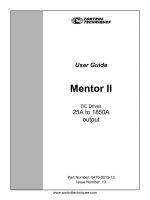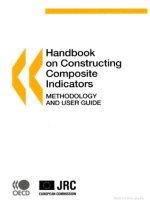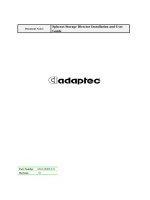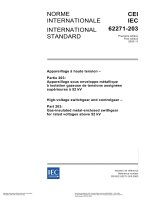High Voltage Xlpe Cable Systems - Technical User Guide pptx
Bạn đang xem bản rút gọn của tài liệu. Xem và tải ngay bản đầy đủ của tài liệu tại đây (3.04 MB, 27 trang )
HIGH VOLTAGE XLPE CABLE SYSTEMS
Technical User Guide
Simpo PDF Merge and Split Unregistered Version -
High Voltage XLPE Cable Systems Techincal User Guide
Brugg Cables Page 2
Content
1. General information on High Voltage XLPE Cable Systems ______________
1.1. Introduction _______________________________________________
1.2. Cable selection process _____________________________________
1.3. Service life ________________________________________________
2. Cable layout and system design ___________________________________
2.1. Electrical field _____________________________________________
2.2. Capacity, charging current ___________________________________
2.3. Inductance, Inductive reactance _______________________________
2.4. Losses in cables ___________________________________________
2.5. Earthing methods, induced voltage _____________________________
2.6. Short-circuit current capacity __________________________________
2.7. Dynamic forces ____________________________________________
2.8. Metallic sheath types ________________________________________
3. XLPE Cable System Standards ____________________________________
4. Technical data sheets ___________________________________________
500 / 290 kV XLPE Cable
400 / 230 kV XLPE Cable
345 / 200 kV XLPE Cable
220 / 127 kV XLPE Cable
132 / 76 kV XLPE Cable
5. XLPE Cable Reference Projects from Brugg __________________________
3
3
3
4
6
6
6
7
7
8
10
11
11
13
14
20
Simpo PDF Merge and Split Unregistered Version -
High Voltage XLPE Cable Systems Techincal User Guide
Brugg Cables Page 3
1. General information on High Voltage
Cable Systems
1.1 Introduction
The development of high voltage XLPE Cable
Systems goes back to the 1960’s. Since then
production and material technology have
improved significantly, providing reliable and
maintenance-free products to the utility industry.
At present, numerous high voltage XLPE cable
systems with nominal voltages up to 500 kV and
with circuit lengths up to 40 km are in operation
worldwide.
Cable systems are equipped with accessories,
which have passed the relevant type tests
pursuant to national and international standards,
such as long-duration tests. As one of the first
XLPE cable manufacturers worldwide Brugg
Cables passed a Prequalification Test on a
400 kV XLPE Cable System according to the
relevant international standard IEC 62067 (2001).
This test required one year of operation, along
with the thermal monitoring of all cables, joints
and terminations installed. It was successfully
completed at CESI Laboratory in Milan, Italy in
2004.
Test Setup of Prequalification Test
As one of just a few providers worldwide, Brugg
Cables can offer a broad range of both XLPE
cables (up to 500 kV) and oil-filled cables (up to
400 kV) as well as their accessories.
Typical sample of a 2500mm
2
500 kV XLPE cable
Modern XLPE cables consist of a solid cable core,
a metallic sheath and a non-metallic outer
covering. The cable core consists of the
conductor, wrapped with semiconducting tapes,
the inner semiconducting layer, the solid main
insulation and the outer semiconducting layer.
These three insulation layers are extruded in one
process. The conductor of high voltage cables can
be made of copper or aluminium and is either
round stranded of single wires or additionally
segmented in order to to reduce the current
losses.
Depending on the customer’s specifications it can
be equipped with a longitudinal water barrier
made of hygroscopic tapes or powder. The main
insulation is cross-linked under high pressure and
temperature. The metallic sheath shall carry the
short-circuit current in case of failure. It can be
optionally equipped with fibers for temperature
monitoring. Finally, the outer protection consists of
extruded Polyethylene (PE) or Polyvinylchloride
(PVC) and serves as an anti-corrosion layer.
Optionally it can be extruded with a
semiconducting layer for an after-laying test and
additionally with a flame-retardant material for
installation in tunnels or buildings if required.
1.2 Cable selection process
This broad product range together with a
systematic analysis of the technical requirements
enables the user to find the right solution for every
application. Additionally, our consulting engineers
can assist you in the development of customized
solutions.
Simpo PDF Merge and Split Unregistered Version -
High Voltage XLPE Cable Systems Techincal User Guide
Brugg Cables Page 4
Selection process of cable design
1.3 Service life
Cables are among the investment goods with a
high service life of over 40 years. The service life
of a cable is defined as its operating time. It is
influenced by the applied materials, the
constructive design, the production methods and
the operating parameters.
Regarding the material technology Brugg Cables
has many years of experience and investigation
together with extensive experience in the field of
cable systems gained over the years.
Lifetime curve of XLPE cables
Lifetime curve of XLPE cables
0
5
10
15
20
25
30
35
40
45
50
1,0E+00 1,0E+01 1,0E+02 1,0E+03 1,0E+04
Cable lifetime (hours)
Breakdown stress
(kV/mm)
Customer
requirements
Load, Voltage level,
Short-
circuit current,
Laying condition
Type of
Insulation
Cable type
and design
Economic
aspects
(Price, Losses)
Conductor
Material (Cu, Al)
Route length
and layout
Earthing method
of sheath
Economic
aspects,
Safety margin
Conductor
cross-section
Indoor or Outdoor Selection of
cable accessories
Losses,
Economic
aspects
Determination of
Laying condition
Local boundaries,
Safety regulation
Leakage path
requirements
Short-circuit and
thermal rating
Simpo PDF Merge and Split Unregistered Version -
High Voltage XLPE Cable Systems Techincal User Guide
Brugg Cables Page 5
The following rules apply for all organic insulation
materials in general:
- An increase of the operating temperature by 8
to 10°C reduces the service life by half.
- An increase of the operating voltage by 8 to
10% reduces the service life by half.
The influence of the voltage on the service life is
expressed in the following service life law
(see graph above):
t E
n
= const
with
E = Maximum field strength at the conductor
surface of the cable
n = Exponent stating the slope
t = Time
Other operating parameters of decisive
importance are:
- Voltage level and transient voltages such as
switch operations, lightning impulses
- Short-circuit current and related conductor
temperatures
- Mechanical stress
- Ambient conditions like humidity, ground
temperatures, chemical influences
- Rodents and termites in the vicinity
Simpo PDF Merge and Split Unregistered Version -
High Voltage XLPE Cable Systems Techincal User Guide
Brugg Cables Page 6
2. Cable layout and system design
The dimensioning of a high voltage cable system
is always based on the specifications and
demands of the project at hand. The following
details are required for calculation:
- The type of cable insulation
- Nominal and maximum operating voltage
- Short-circuit capacity or short-circuit current with
statement of the effect time
- Transmission capacity or nominal current
- Operating mode: permanent operation or partial
load operation (load factors)
- Ambient conditions:
Type of installation
Ambient temperatures (incl. external effects)
Special thermal resistance of the ground
The calculation of the admissible load currents
(ampacity) and the cable temperatures is
performed in accordance with the IEC publication
60287. At Brugg Cables, professional computer
programs are in use for the calculation of the
various cable data.
2.1 Electrical field
In initial approximation, the main insulation of a
high voltage XLPE cable can be regarded as a
homogenous cylinder. Its field distribution or
voltage gradient is therefore represented by a
homogenoius radial field. The value of the voltage
gradient at a point x within the insulation can
therefore be calculated as:
i
a
x
o
x
r
r
r
U
E
ln
(kV/mm)
with
U
o
= Operating voltage (kV)
r
x
= Radius at position x (mm)
r
a
= External radius above the insulation (mm)
r
i
= Radius of the internal field delimiter (mm)
The electrical field strength is highest at the inner
semiconductor and lowest above the insulation
(below the external semiconductor, r
x
= r
a
).
Field distribution within a high voltage XLPE cable
2.2 Capacity, charging current
The operating capacity depends on the type of
insulation and its geometry. The following formula
applies for all radial field cables:
d
D
C
r
b
ln
56.5
(F/km)
with
r
= Relative permittivity (XLPE: 2,4)
D = Diameter over main insulation (mm)
d = Diameter over inner semiconducter (mm)
Single-core high voltage XLPE cables represent
an extended capacitance with a homogenous
radial field distribution. Thus a capacitive charging
current to earth results in the following formula:
bC
CUI
0
(A/km)
with
U
o
= Operating voltage (kV)
= Angular frequency (1/s)
C
b
= Operating capacity (µF/km)
E
x
r
i
r
x
r
a
Simpo PDF Merge and Split Unregistered Version -
High Voltage XLPE Cable Systems Techincal User Guide
Brugg Cables Page 7
2.3 Inductance, Inductive reactance
The operating inductance in general depends on
the relation between the conductor axis spacing
and the external conductor diameter. Practically,
two cases have to be considered:
Laying formation: trefoil
The operating inductance for all three phases
calculates as:
L
r
a
L
779,0
ln102
4
(H/km)
with
a = Phase axis distance (mm)
r
L
= Diameter of conductor over inner
semiconducting layer (mm)
Laying formation: flat
The mean operating inductance for the three
phases calculates as
L
m
r
a
L
779,0
'
ln102
4
(H/km)
with
a’ =
a
3
2
Mean geometric distance (mm)
a = Phase axis distance (mm)
r
L
= Diameter of conductor over inner
semiconducting layer (mm)
The inductive reactance of the cable system
calculates for both cases as:
LX
[/km]
with
= Angular frequency (1/s)
2.4 Losses in cables
Voltage-dependent and current-dependent power
losses occur in cables.
I) Voltage-dependent losses
Voltage-dependent power losses are caused by
polarization effects within the main insulation.
They calculate to:
tan
2
bod
CUP (W/km)
with
U
o
= Operating voltage (kV)
= Angular frequency (1/s)
C
b
= Operating capacity (µF/km)
Dielectric power loss factors tan for typical cable
insulations are:
XLPE (1,5 to 3,5) 10
–4
EPR (10 to 30) 10
–4
Oil cable (18 to 30) 10
–4
II) Current-dependent losses
The current-dependent losses consist of the
following components:
- Ohmic conductor losses
- Losses through skin effect
- Losses through proximity effect
- Losses in the metal sheath
Ohmic conductor losses
The ohmic losses depend on material and
temperature. For the calculation of the ohmic
losses R I², the conductor resistance stated for
20°C (R
o
) must be converted to the operating
temperature of the cable:
R = R
o
[1 + ( - 20°C )] [/km]
with
= 0.0393 for Copper
= 0.0403 for Aluminium
The conductor cross-section and admissible DC
resistances at 20°C (R
o
) correspond to the
standards series pursuant to IEC 60228.
a
a
a
2r
a
a
2r
Simpo PDF Merge and Split Unregistered Version -
High Voltage XLPE Cable Systems Techincal User Guide
Brugg Cables Page 8
Losses through skin effect
The losses caused by the skin effect, meaning the
displacement of the current against the conductor
surface, rise approximately quadratic with the
frequency. This effect can be reduced with
suitable conductor constructions, e.g. segmented
conductors.
Losses through proximity effect
The proximity effect detects the additional losses
caused by magnet fields of parallel conductors
through eddy currents and current displacement
effects in the conductor and cable sheath. In
practice, their influence is of less importance,
because three-conductor cables are only installed
up to medium cross-sections and single-conductor
cables with large cross-sections with sufficient
axis space. The resistance increase through
proximity effects relating to the conductor
resistance is therefore mainly below 10%.
Losses in the metal sheath
High voltage cables are equipped with metal
sheaths or screens that must be earthed
adequately.
Sheath losses occur through:
- Circulating currents in the system
- Eddy currents in the cable sheath
(only applicable for tubular types)
- Resulting sheath currents caused by induced
sheat voltage (in unbalanced earting systems)
The sheath losses, especially high circulating
currents, may substantially reduce the current
load capacity under certain circumstances. They
can be lowered significantly through special
earthing methods.
2.5 Earthing methods, induced voltage
High voltage cables have a metallic sheath, along
which a voltage is induced as a function of the
operating current. In order to handle this induced
voltage, both cable ends have to be bonded
sufficiently to the earthing system. The following
table gives an overview of the possible methods
and their characteristics:
Earthing method
Standing voltage
at cable ends
Sheath voltage
limiters required
Typical application
Both-end bonding No No
Substations, short connections,
hardly applied for HV cables,
rahter for MV and LV cables
Single-end bonding Yes Yes
Usually only for circuit lengths
up to 1 km
Cross-bonding
Only at cross-
bonding points
Yes
Long distance connections
where joints are required
Overview of earthing methods and their characteristics
Both-end bonding
Both ends of the cable sheath are connected to
the system earth. With this method no standing
voltages occur at the cable ends, which makes it
the most secure regarding safety aspects. On the
other hand, circulating currents may flow in the
sheath as the loop between the two earthing
points is closed through the ground. These
circulating currents are proportional to the
conductor currents and therefore reduce the cable
ampacity significantly making it the most
disadvantegous method regarding economic
aspects.
Induced voltage distribution at both-end bonding
U
x
Simpo PDF Merge and Split Unregistered Version -
High Voltage XLPE Cable Systems Techincal User Guide
Brugg Cables Page 9
Single-ended Bonding
One end of the cable sheath is connected to the
system earth, so that at the other end (“open
end”) the standing voltage appears, which is
induced linearily along the cable length. In order
to ensure the relevant safety requirements, the
“open end” of the cable sheath has to be
protected with a surge arrester. In order to avoid
potential lifting in case of a failure, both earth
points have to be connected additionally with an
earth continuity wire. The surge arrester (sheath
voltage limiter) is designed to deflect switching
and atmospheric surges but must not trigger in
case of a short-circuit.
Induced voltage distribution at single-end bonding
Cross-bonding
This earthing method shall be applied for longer
route lengths where joints are required due to the
limited cable delivery length. A cross-bonding
system consists of three equal sections with cyclic
sheath crossing after each section. The
termination points shall be solidly bonded to earth.
Induced voltage distribution at cross-bonding
Along each section, a standing voltage is induced.
In ideal cross-bonding systems the three section
lengths are equal, so that no residual voltage
occurrs and thus no sheath current flows. The
sheath losses can be kept very low with this
method without impairing the safety as in the two-
sided sheath earthing.
Very long route lengths can consist of several
cross-bonding systems in a row. In this case, it is
recommended to maintain solid bonding of the
system ends in order to prevent travelling surges
in case of a fault.
In addition to cross-linking the sheaths, the
conductor phases can be transposed cyclicly. This
solution is especially suited for very long cable
engths or parallel circuits.
U
x
earth con
tinuity
U
x
L1
L2
L3
Section 1
Section 2
Section 3
Simpo PDF Merge and Split Unregistered Version -
High Voltage XLPE Cable Systems Techincal User Guide
Brugg Cables Page 10
Calculation of the induced voltage
The induced voltage U
i
within a cable system
depends on the mutual inductance between core
and sheath, the conductor current and finally on
the cable length:
LIXU
Mi
(V)
with
X
M
= Mutual inductance between core and sheath
(/km)
I = Conductor current per phase (A)
L = Cable length
Two cases must be considered for the
determination of the maximum occurring voltage
and for the dimensioning of the surge arresters:
I = I
N
Normal operating current (A)
I = I
c
Three-pole Short-circuit current (A)
The mutual inductance between core and sheath
calculates from the following formula:
MM
LX (/km)
with
= Angular frequency (1/s)
and where L
M
is the mutual inductivity between
core and sheath (H/km).
The mutual inductivity between core and sheath
L
M
calculates as follows:
For installation in trefoil formation:
M
M
d
a
L
2
ln102
7
(H/km)
For installation in flat formation:
M
M
d
a
L
3
7
22
ln102 (H/km)
with
a = Axial spacing (mm)
d
M
= Mean sheath diameter (mm)
2.6 Short-Circuit current capacity
For the cable system layout, the maximum short-
circuit current capacity for both – the conductor
and the metallic sheath – have to be calculated.
Both values are depending on
- the duration of the short-circuit current
- the material of the current carrying component
- the type of material of the adjacent
components and their admissible temperatue
The duration of a short circuit consists of the
inherent delay of the circuit breaker and the relay
time.
Short-Circuit current capacity of conductors
The following table contains the maximum
admissible short-circuit currents I
k,1s
for
conductors acc. to IEC 60949 with a duration of
1 second for the different conductor and insulation
types.
Insulation
material XLPE Oil
Conductor
material Cu Al Cu
mm2
kA
1s; 90 250°C
kA
1s; 85 165°C
2500 358 237 260
2000 287 190 208
1600 229 152 166
1400 201 133 -
1200 172 114 125
1000 143 95 104
800 115 76 83
630 90 60 66
500 72 47 52
400 57 38 42
300 43 28 31
240 34 23 25
Admissible short-circuit currents
Simpo PDF Merge and Split Unregistered Version -
High Voltage XLPE Cable Systems Techincal User Guide
Brugg Cables Page 11
Based on these reference values, the short-circuit
currents for other durations can be converted with
the following formula:
sk
c
xk
I
t
I
1,,
1
with
I
kx
= Short-circuit current during x seconds [kA]
tc = Duration of short-circuit [s]
I
k,1s
= Short-circuit current during 1 second [kA]
The above stated values were calculated on a
non-adiabatic basis, which means that heat
transfer from the current carrying componen to its
adjacent components is allowed.
Short-Circuit current capacity of metallic sheaths
In addition to the above mentioned, the short-
circuit current capacity of metallic sheaths
depends on their layout. The short-circuit current
capacity is different for tubular sheats and wire
screens, but generally the total short-circuit
current capacity of a metallic sheath is the sum of
the capacity of its components.
Typical metallic sheath layouts with their
constructional details are listed in a separate
section.
2.7 Dynamic forces
Single-core cables have to be fixed in their
position at certain intervals. The calculation of
dynamic forces for cable systems is important for
the determination of the fixing interval and the
layout of the fixing devices. It has to be
distinguished between radial (e.g. clamps,
spacers) and tangential (belts etc.) forces.
The amplitude of a dynamic force in general is
calculated applying the following formula:
a
I
F
s
s
27
102
(kN/m)
with
a = Phase axis distance (mm)
cs
II 2
wherein
l
s
= Impulse short-circuit current [kA]
= surge factor (usually defined as 1.8)
l
c
= Short-circuit current [kA]
Radial force
The dynamic force that a spacer has to absorb is:
sr
FF
F
s
= Dynamic force [kN/m]
= Layout factor (typical value for mid phase:
0.866)
Tangential force
The dynamic force that a fixing belt has to absorb
is:
st
FF
F
s
= Dynamic force [kN/m]
= Layout factor (value for trefoil: 0.5)
2.8 Metallic sheath types
The metallic sheath of high voltage XLPE single
core cables has to fulfill the following electrical
requirements:
- Conducting the earth fault current
- Returning the capacitive charging current
- Limitation of the radial electrostatic field
- Shielding of the electromagnetic field
Since high voltage XLPE cables are very sensitive
to moisture ingression, the metallic sheath also
serves as radial moisture barrier. There are
several modes of preventing water and moisture
penetrating into the cable and travelling within it
along its length. Solutions for closed metallic
sheathes can be based on welding, extruding or
gluing. Some typical sheath layouts as available
from Brugg Cables are shown in the following
table.
Simpo PDF Merge and Split Unregistered Version -
High Voltage XLPE Cable Systems Techincal User Guide
Brugg Cables Page 12
Typical metallic sheath types
Brugg type XDRCU-ALT Brugg type XDRCU-ALT
Aluminium laminated sheath
with Copper wire screen
Aluminium laminated sheath
with Copper wire screen and
integrated fibres for temperature sensing
Features:
- Low weight
- Low losses
- Low cost
Features:
- Low weight
- Low losses
- Low cost
Typical application:
Installation in tunnels, trenches or ducts
Typical applications:
Installation in tunnels, trenches or ducts
Brugg type XDRCU-CUT Brugg type XDCUW-T
Copper laminated sheath
with Copper wire screen
Copper corrugated sheath
Features:
- Low weight
- Low losses
- Low cost
Features:
- 100% impervious to moisture
- flexible
- resistant to deformation, pressure and
corrosion
- welded
Typical applications:
Installation in tunnels, trenches or ducts
Typical applications:
All installations in soil, especially in locations
with shallow ground water level
Special application:
Installation in vertical shafts (up to 220 m)
Brugg type XDPB-T Brugg type XDRCU-PBT
Lead sheath Lead sheath
with Copper wire screen
Features:
- 100% impervious to moisture
- seamless
- extruded
Features:
- 100% impervious to moisture
- seamless
- extruded
- increased short-circuit capacity through
additional copper wire screen
Typical applications:
All installations in soil
Typical applications:
All installations in soil
Simpo PDF Merge and Split Unregistered Version -
High Voltage XLPE Cable Systems Techincal User Guide
Brugg Cables Page 13
3. XLPE Cable System Standards
Brugg Cables´ XLPE cable systems are designed to meet requirements set in national and international
standards. Some of these are listed below.
IEC
XLPE cable systems specified according to IEC (International Electrotechnical Commission) are among
many other standards accepted.
Some frequently used standards are:
IEC 60183 Guide to the selection of high-voltage cables.
IEC 60228 Conductors of insulated cables.
IEC 60229 Tests on cable oversheaths which have a special protective function and are applied by
extrusion.
IEC 60287 Electric cables – Calculation of the current rating.
IEC 60332 Tests on electric cables under fire conditions.
IEC 60811 Common test methods for insulating and sheathing materials of electric cables.
IEC 60840 Power cables with extruded insulation and their accessories for rated voltage above
30 kV (Um=36 kV) up to 150 kV (Um=170 kV). Test methods and requirements.
IEC 60853 Calculation of the cyclic and emergency current rating of cables.
IEC 61443 Short-circuit temperature limits of electric cables with rated voltages above
30 kV (Um=36 kV)
IEC 62067 Power cables with extruded insulation and their accessories for rated voltage above
150 kV (Um=170 kV) up to 500 kV (Um=550 kV) - Test methods and requirements
CENELEC
In Europe, cable standards are issued by CENELEC. (European Committee for Electrotechnical
Standardisation.) Special features in design may occur depending on national conditions.
HD 632 Power cables with extruded insulation and their accessories for rated voltage above
36 kV (Um=42 kV) up to 150 kV (Um=170 kV). Part 1- General test requirements.
Part 1 is based on IEC 60840 and follows that standard closely.
HD 632 is completed with a number of parts and subsections for different cables intended to be
used under special conditions which can vary nationally in Europe.
ICEA / ANSI / AEIC
For North America cables are often specified according to
- AEIC (Association of Edison Illuminating Companies)
- ICEA (Insulated Cable Engineers Association)
- ANSI (American National Standards Institute) or
The most frequently standards referred to are:
AEIC CS7-93 Specifications for crosslinked polyethylene insulated shielded power cables rated
69 through 138 kV.
ANSI / ICEA S-108-720-2004 Standard for extruded insulation power cables rated above 46 through
345 kV
ISO Standards
Our systems comply with the requirements of ISO 9001 and ISO 14001 and are certified by Bureau Veritas
Quality International.
Simpo PDF Merge and Split Unregistered Version -
High Voltage XLPE Cable Systems Techincal User Guide
Brugg Cables Page 14
4. Technical data sheets
500 / 290 kV XLPE Cable - Technical data and Ampacity
400 / 230 kV XLPE Cable - Technical data and Ampacity
345 / 200 kV XLPE Cable - Technical data and Ampacity
220 / 127 kV XLPE Cable - Technical data and Ampacity
132 / 76 kV XLPE Cable - Technical data and Ampacity
Simpo PDF Merge and Split Unregistered Version -
500/290 kV XLPE Cable
© 05.2006 Subject to modifications 1/1
Single-core XLPE High Voltage Cable
with Aluminium laminated sheath
Cable layout
Copper conductor, stranded, cross-sections of
1000 sqmm and above segmented, optionally
with longitudinal water barrier
Inner semiconductive layer, firmly bonded to the
XLPE insulation
XLPE main insulation, cross-linked
Outer semiconductive layer, firmly bonded to
the XLPE insulation
Copper wire screen with semi-conductive
swelling tapes as longitudinal water barrier
Aluminium lamninated sheath
HDPE oversheath, halogen-free, as mechanical
protection, optionally: with semi-conductive
and/or flame-retardant layer
Production process
The inner semiconductive layer, the
XLPE main insulation and the outer
semiconductive layer are extruded in a
single operation.
Special features of metallic sheath
Copper wire screen as short-circuit
current carrying component
Aluminium foil, overlapped,
0,25 mm thick, as radial diffusion
barrier
Low weight, low cost,
internationally proven design
Applicable standards
IEC 62067 (2001)
XDRCU-ALT
500/290 kV
Technical data
Copper conductor
cross-section
Outer
diameter
approx.
Cable weight
appox.
Capacitance Impedance
(90°C, 50 Hz)
• • •
Surge
impedance
Min. bending
radius
Max. pulling
force
mm
2
kcmil mm kg/m µF/km Ω/km Ω mm kN
630 1250 122 18 0.12 0.22 54 2450 38
800 1600 123 20 0.14 0.20 49 2500 48
1000 2000 127 23 0.16 0.19 47 2550 60
1200 2400 128 24 0.17 0.19 44 2600 72
1400 2750 129 26 0.19 0.18 42 2600 84
1600 3200 135 29 0.19 0.18 42 2700 96
2000 4000 143 34 0.19 0.17 40 2900 120
2500 5000 144 40 0.23 0.17 37 2900 150
Ampacity
Buried in soil
•
•
•
Buried in soil
•
•
•
Buried in soil
• • •
Buried in soil
• • •
In free air
•
•
•
In free air
• • •
Load Factor 0.7 1.0 0.7 1.0 - -
mm
2
kcmil A A A A A A
630 1250 954 806 1026 882 1053 1152
800 1600 1076 901 1170 998 1211 1341
1000 2000 1268 1055 1377 1166 1452 1608
1200 2400 1369 1134 1497 1261 1588 1772
1400 2750 1473 1215 1622 1361 1728 1944
1600 3200 1561 1286 1718 1440 1835 2068
2000 4000 1711 1403 1901 1585 2045 2326
2500 5000 1873 1522 2120 1751 2301 2670
Calculation basis:
Conductor temperature 90°C, 50 Hz, soil temperature 25°C, laying depth 1200 mm, soil thermal resistivity 1.0 Km/W,
phase distance at flat formation 30 cm, air temperature 35° - Earthing method: Single-end bonding or Cross-bonding
Simpo PDF Merge and Split Unregistered Version -
400/230 kV XLPE Cable
© 05.2006 Subject to modifications 1/1
Single-core XLPE High Voltage Cable
with Aluminium laminated sheath
Cable layout
Copper conductor, stranded, cross-sections of
1000 sqmm and above segmented, optionally
with longitudinal water barrier
Inner semiconductive layer, firmly bonded to the
XLPE insulation
XLPE main insulation, cross-linked
Outer semiconductive layer, firmly bonded to
the XLPE insulation
Copper wire screen with semi-conductive
swelling tapes as longitudinal water barrier
Aluminium lamninated sheath
HDPE oversheath, halogen-free, as mechanical
protection, optionally: with semi-conductive
and/or flame-retardant layer
Production process
The inner semiconductive layer, the
XLPE main insulation and the outer
semiconductive layer are extruded in a
single operation.
Special features of metallic sheath
Copper wire screen as short-circuit
current carrying component
Aluminium foil, overlapped,
0,25 mm thick, as radial diffusion
barrier
Low weight, low cost,
internationally proven design
Applicable standards
IEC 62067 (2001)
XDRCU-ALT
400/230 kV
Technical data
Copper conductor
cross-section
Outer
diameter
approx.
Cable weight
appox.
Capacitance Impedance
(90°C, 50 Hz)
• • •
Surge
impedance
Min. bending
radius
Max. pulling
force
mm
2
kcmil mm kg/m µF/km Ω/km Ω mm kN
500 1000 113 16 0.12 0.23 56 2300 30
630 1250 114 17 0.13 0.22 53 2300 38
800 1600 115 18 0.15 0.20 48 2300 48
1000 2000 118 21 0.17 0.19 45 2400 60
1200 2400 122 24 0.19 0.19 43 2450 72
1400 2750 123 25 0.20 0.18 41 2450 84
1600 3200 128 28 0.20 0.18 40 2600 96
2000 4000 135 33 0.21 0.17 39 2700 120
2500 5000 136 38 0.26 0.17 35 2700 150
Ampacity
Buried in soil
•
•
•
Buried in soil
•
•
•
Buried in soil
• • •
Buried in soil
• • •
In free air
•
•
•
In free air
• • •
Load Factor 0.7 1.0 0.7 1.0 - -
mm
2
kcmil A A A A A A
500 1000 853 723 912 788 924 1006
630 1250 972 819 1049 900 1068 1173
800 1600 1098 917 1199 1020 1228 1367
1000 2000 1298 1076 1416 1195 1478 1647
1200 2400 1402 1158 1534 1290 1612 1804
1400 2750 1509 1241 1665 1394 1755 1980
1600 3200 1600 1315 1767 1477 1869 2112
2000 4000 1760 1440 1956 1628 2078 2376
2500 5000 1931 1565 2190 1804 2347 2739
Calculation basis:
Conductor temperature 90°C, 50 Hz, soil temperature 25°C, laying depth 1200 mm, soil thermal resistivity 1.0 Km/W,
phase distance at flat formation 30 cm, air temperature 35° - Earthing method: Single-end bonding or Cross-bonding
Values apply for cables with rated voltages from 380 kV to 400 kV acc. to IEC 62067
Simpo PDF Merge and Split Unregistered Version -
345/200 kV XLPE Cable
© 05.2006 Subject to modifications 1/1
Single-core XLPE High Voltage Cable
with Aluminium laminated sheath
Cable layout
Copper conductor, stranded, cross-sections of
1000 sqmm and above segmented, optionally
with longitudinal water barrier
Inner semiconductive layer, firmly bonded to the
XLPE insulation
XLPE main insulation, cross-linked
Outer semiconductive layer, firmly bonded to
the XLPE insulation
Copper wire screen with semi-conductive
swelling tapes as longitudinal water barrier
Aluminium lamninated sheath
HDPE oversheath, halogen-free, as mechanical
protection, optionally: with semi-conductive
and/or flame-retardant layer
Production process
The inner semiconductive layer, the
XLPE main insulation and the outer
semiconductive layer are extruded in a
single operation.
Special features of metallic sheath
Copper wire screen as short-circuit
current carrying component
Aluminium foil, overlapped,
0,25 mm thick, as radial diffusion
barrier
Low weight, low cost,
internationally proven design
Applicable standards
IEC 62067 (2001)
ANSI / ICEA S-108-720-2004
XDRCU-ALT
345/200 kV
Technical data
Copper conductor
cross-section
Outer
diameter
approx.
Cable weight
appox.
Capacitance Impedance
(90°C, 50 Hz)
• • •
Surge
impedance
Min. bending
radius
Max. pulling
force
mm
2
kcmil mm kg/m µF/km Ω/km Ω mm kN
500 1000 113 16 0.12 0.23 56 2300 30
630 1250 114 17 0.13 0.22 53 2300 38
800 1600 115 18 0.15 0.20 48 2300 48
1000 2000 118 21 0.17 0.19 45 2400 60
1200 2400 122 24 0.19 0.19 43 2450 72
1400 2750 123 25 0.20 0.18 41 2450 84
1600 3200 128 28 0.20 0.18 40 2600 96
2000 4000 135 33 0.21 0.17 39 2700 120
2500 5000 136 38 0.26 0.17 35 2700 150
Ampacity
Buried in soil
•
•
•
Buried in soil
•
•
•
Buried in soil
• • •
Buried in soil
• • •
In free air
•
•
•
In free air
• • •
Load Factor 0.7 1.0 0.7 1.0 - -
mm
2
kcmil A A A A A A
500 1000 859 728 918 793 927 1009
630 1250 980 825 1056 906 1072 1176
800 1600 1108 925 1208 1027 1233 1371
1000 2000 1311 1087 1427 1205 1485 1652
1200 2400 1416 1170 1547 1301 1619 1810
1400 2750 1526 1255 1680 1407 1763 1987
1600 3200 1617 1329 1783 1491 1877 2120
2000 4000 1780 1456 1975 1643 2088 2384
2500 5000 1956 1586 2214 1825 2359 2750
Calculation basis:
Conductor temperature 90°C, 50 Hz, soil temperature 25°C, laying depth 1200 mm, soil thermal resistivity 1.0 Km/W,
phase distance at flat formation 30 cm, air temperature 35° - Earthing method: Single-end bonding or Cross-bonding
Values apply for cables with rated voltages from 330 kV to 345 kV acc. to IEC 62067
Simpo PDF Merge and Split Unregistered Version -
220/127 kV XLPE Cable
© 05.2006 Subject to modifications 1/1
Single-core XLPE High Voltage Cable
with Aluminium laminated sheath
Cable layout
Copper conductor, stranded, cross-sections of
1000 sqmm and above segmented, optionally
with longitudinal water barrier
Inner semiconductive layer, firmly bonded to the
XLPE insulation
XLPE main insulation, cross-linked
Outer semiconductive layer, firmly bonded to
the XLPE insulation
Copper wire screen with semi-conductive
swelling tapes as longitudinal water barrier
Aluminium lamninated sheath
HDPE oversheath, halogen-free, as mechanical
protection, optionally: with semi-conductive
and/or flame-retardant layer
Production process
The inner semiconductive layer, the
XLPE main insulation and the outer
semiconductive layer are extruded in a
single operation.
Special features of metallic sheath
Copper wire screen as short-circuit
current carrying component
Aluminium foil, overlapped,
0,25 mm thick, as radial diffusion
barrier
Low weight, low cost,
internationally proven design
Applicable standards
IEC 62067 (2001)
ANSI / ICEA S-108-720-2004
XDRCU-ALT
220/127 kV
Technical data
Copper conductor
cross-section
Outer
diameter
approx.
Cable weight
appox.
Capacitance Impedance
(90°C, 50 Hz)
• • •
Surge
impedance
Min. bending
radius
Max. pulling
force
mm
2
kcmil mm kg/m µF/km Ω/km Ω mm kN
300 600 99 12 0.11 0.25 59 2000 18
500 1000 99 13 0.13 0.23 54 2000 30
630 1250 100 15 0.15 0.22 51 2000 38
800 1600 105 17 0.18 0.20 46 2100 48
1000 2000 111 20 0.19 0.19 44 2250 60
1200 2400 112 22 0.22 0.19 41 2250 72
1400 2750 115 24 0.22 0.18 40 2300 84
1600 3200 116 26 0.25 0.18 38 2350 96
2000 4000 119 30 0.27 0.17 36 2400 120
2500 5000 129 37 0.28 0.17 34 2600 150
Ampacity
Buried in soil
•
•
•
Buried in soil
•
•
•
Buried in soil
• • •
Buried in soil
• • •
In free air
•
•
•
In free air
• • •
Load Factor 0.7 1.0 0.7 1.0 - -
mm
2
kcmil A A A A A A
300 600 670 571 714 621 707 768
500 1000 877 739 945 813 944 1038
630 1250 1001 838 1090 930 1092 1213
800 1600 1130 939 1241 1051 1252 1405
1000 2000 1339 1106 1462 1231 1508 1687
1200 2400 1450 1192 1595 1336 1651 1863
1400 2750 1561 1280 1725 1440 1791 2031
1600 3200 1657 1353 1847 1536 1919 2195
2000 4000 1824 1482 2060 1703 2147 2490
2500 5000 2002 1618 2282 1876 2397 2815
Calculation basis:
Conductor temperature 90°C, 50 Hz, soil temperature 25°C, laying depth 1200 mm, soil thermal resistivity 1.0 Km/W,
phase distance at flat formation 30 cm, air temperature 35° - Earthing method: Single-end bonding or Cross-bonding
Values apply for cables with rated voltages from 220 kV to 230 kV acc. to IEC 62067
Simpo PDF Merge and Split Unregistered Version -
132/76 kV XLPE Cable
© 05.2006 Subject to modifications 1/1
Single-core XLPE High Voltage Cable
with Aluminium laminated sheath
Cable layout
Copper conductor, stranded, cross-sections of
1000 sqmm and above segmented, optionally
with longitudinal water barrier
Inner semiconductive layer, firmly bonded to the
XLPE insulation
XLPE main insulation, cross-linked
Outer semiconductive layer, firmly bonded to
the XLPE insulation
Copper wire screen with semi-conductive
swelling tapes as longitudinal water barrier
Aluminium lamninated sheath
HDPE oversheath, halogen-free, as mechanical
protection, optionally: with semi-conductive
and/or flame-retardant layer
Production process
The inner semiconductive layer, the
XLPE main insulation and the outer
semiconductive layer are extruded in a
single operation.
Special features of metallic sheath
Copper wire screen as short-circuit
current carrying component
Aluminium foil, overlapped,
0,25 mm thick, as radial diffusion
barrier
Low weight, low cost,
internationally proven design
Applicable standards
IEC 60840 (2004-04)
AEIC CS7-93
ANSI / ICEA S-108-720-2004
XDRCU-ALT
132/76 kV
Technical data
Copper conductor
cross-section
Outer
diameter
approx.
Cable weight
appox.
Capacitance Impedance
(90°C, 50 Hz)
• • •
Surge
impedance
Min. bending
radius
Max. pulling
force
mm
2
kcmil mm kg/m µF/km Ω/km Ω mm kN
240 500
73 6 0,13 0,26 59 1500
14
300 600
76 7 0,14 0,25 49 1550
18
400 800
77 8 0,16 0,23 49 1600
24
500 1000
83 9 0,16 0,22 49 1700
30
630 1250
86 10 0,18 0,22 49 1750
38
800 1600
87 12 0,24 0,20 42 1800
48
1000 2000
91 14 0,27 0,19 39 1850
60
1200 2400
95 15 0,30 0,19 37 1900
72
1400 2750
96 21 0,34 0,18 34 1950
84
1600 3200
99 22 0,35 0,18 33 2000
96
2000 4000
104 27 0,39 0,17 31 2100
120
2500 5000
111 33 0,43 0,17 29 2250
150
Ampacity
Buried in soil
•
•
•
Buried in soil
•
•
•
Buried in soil
• • •
Buried in soil
• • •
In free air
•
•
•
In free air
• • •
Load Factor 0.7 1.0 0.7 1.0 - -
mm
2
kcmil A A A A A A
240 500
607 513 657 569 631 698
300 600
687 579 745 642 721 799
400 800
789 660 861 737 837 936
500 1000
896 748 979 836 960 1074
630 1250
1020 847 1123 953 1107 1249
800 1600
1154 949 1292 1086 1275 1467
1000 2000
1377 1126 1530 1276 1550 1776
1200 2400
1488 1212 1661 1380 1691 1947
1400 2750
1605 1302 1810 1497 1843 2147
1600 3200
1699 1377 1925 1589 1964 2297
2000 4000
1869 1507 2147 1763 2195 2603
2500 5000
2050 1643 2396 1954 2456 2969
Calculation basis:
Conductor temperature 90°C, 50 Hz, soil temperature 25°C, laying depth 1200 mm, soil thermal resistivity 1.0 Km/W,
phase distance at flat formation 30 cm, air temperature 35° - Earthing method: Single-end bonding or Cross-bonding
Values apply for cables with rated voltages from 132 kV to 138 kV acc. to IEC 60840
Simpo PDF Merge and Split Unregistered Version -
High Voltage XLPE Cable Systems Techincal User Guide
Brugg Cables Page 20
5. XLPE Cable Reference Projects from Brugg
BRUGG CABLES XLPE cable system experience above 220 kV dates back to the year 1990. Since then,
more than 70 systems have been put in operation sucessfully in this voltage range all over the world.
Furthermore, BRUGG CABLES is one of the leading suppliers of oil-filled cables in the Middle East.
Simpo PDF Merge and Split Unregistered Version -
© Brugg Kabel AG 2006
XLPE Cable Projects
Project:
345kV Circuits K-Street #1 and #2
115kV Circuit Hyde Park
Location:
Boston, USA
End-user:
NStar Electric & Gas
Scope of supply BRUGG:
345kV-XLPE-Kabel 1x2750kcmil (1400mm
2
)
total length: 2‘910 ft (0,9 km)
12 GIS Terminations 345kV
115kV-XLPE-Kabel 1x4000kcmil (2000mm
2
)
total length: 900 ft (0,3 km)
12 GIS Terminations 115kV
Commissioning:
Spring 2006
Photo by courtesy of Mass Electric Co.
Simpo PDF Merge and Split Unregistered Version -
© Brugg Kabel AG 2005
XLPE Cable Projects
Project:
Piacenza Repowering Project
380kV Connection lines
Location:
Piacenza, Italy
End-user:
EDIPOWER
(Joint Venture Edison, Italy & Atel, Switzerland)
Main contractor:
Consortium Piacenza 800
(Techint, Fiat Engineering, Siemens)
Scope of supply BRUGG:
2.4 km 380kV-XLPE-Kabel 1x800mm
2
12 GIS Terminations 380kV
Commissioning:
July 2005
Simpo PDF Merge and Split Unregistered Version -
© Brugg Kabel AG 2005
XLPE Cable Projects
Project:
220kV Connection line
Combined Cycle Power Plant, Block A 800
Location:
Ludwigshafen, Germany
End-user:
BASF AG
Main contractor:
Siemens AG, Erlangen
Scope of supply BRUGG:
20.5 km 220kV XLPE Cable 1x 2000mm
2
6.5 km 220kV XLPE Cable 1x 400mm
2
9 Outdoor Terminations
15 GIS-/Transformer Terminations
12 Cross-Bonding Joints
33 Straight Joints
Commissioning:
October 2004
Simpo PDF Merge and Split Unregistered Version -
© Brugg Kabel AG 2005
XLPE Cable Projects
Project:
400kV & 220kV Connection lines, Shuweihat IWPP
Location:
United Arab Emirates
End-user:
Abu Dhabi Water and Electricity Authority (ADWEA)
Main contractor:
Siemens AG, Erlangen
Scope of supply BRUGG:
9.2 km 400kV-XLPE-Kabel 1x 630mm
2
15 Outdoor Terminations 400kV
15 GIS Terminations 400kV
0.8 km 220kV-XLPE-Kabel 1x1600mm
2
3.7 km 220kV-XLPE-Kabel 1x 630mm
2
12 Outdoor Terminations 220kV
12 GIS Terminations 220kV
Commissioning:
Autumn 2003
Simpo PDF Merge and Split Unregistered Version -
© Brugg Kabel AG 2005
XLPE Cable Projects
Project:
275kV Connection lines, Substation Creux de Chippis
Location:
Switzerland (Valais)
End-user:
Power Stations Gougra Ltd.
Scope of supply BRUGG:
2 km 275kV XLPE Cable 1x 1200mm
2
0.5 km 275kV XLPE Cable 1x 1600mm
2
1 km 275kV XLPE Cable 1x 400mm
2
36 GIS Terminations 300kV
10 Transformer Terminations 300kV
24 Outdoor Terminations 300kV
Commissioning:
May 1997
Simpo PDF Merge and Split Unregistered Version -









